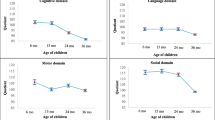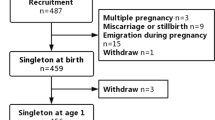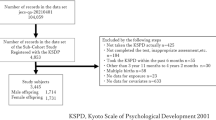Abstract
Objective
Our objective was to evaluate in an exploratory framework the effects of prenatal use of folic acid and other dietary supplements on child development at around 3 years of life.
Methods
Data from the 1988 National Maternal Infant Health Survey and the 1991 follow-up supplement is used. Performance indicators are formed based on 16 developmental assessment items completed by the mother to measure overall as well as domain specific (language, personal-social, gross-motor and fine-motor) development. Pooled as well as separate analyses by child race are performed. Multinomial and binary outcome logistic regression is used and several maternal and household characteristics are included as covariates.
Results
Folic acid use was associated with improved gross-motor development with a more pronounced effect among African-American children, but there was marginally significant poorer performance for the personal-social domain. Zinc and calcium use were associated with increased risks on the overall development scale and two other developmental domains. The negative effects of Zinc on overall development were only observed among white children. On the contrary, vitamin A was associated with decreased risks on the overall development scale only among white children.
Conclusions
Study results suggest that while prenatal folic acid supplementation may improve development at 3 years of age, further research is needed in this regard. The results also emphasize the importance of further research into the use of prenatal calcium and zinc supplementation in a US population.
Similar content being viewed by others
References
MRC Vitamin Study Research Group. (1991). Prevention of neural tube defects: results of the Medical Research Council Vitamin Study. Lancet, 338, 131–137.
Berry, R. J., Li, Z., Erickson, J. D., Li, S., Moore, C. A., Wang, H., Mulinare, J., Zhao, P., Wong, L. Y., Gindler, J., Hong, S. X., & Correa, A. (1999). Prevention of neural-tube defects with folic acid in China. China-U.S. collaborative project for neural tube defect prevention. The New England Journal of Medicine, 341, 1485–1490.
FDA. (1996). Food standards: Amendment of standards of identity for enriched grain products to require addition of folic acid. Federal Register, 61, 8781–8797.
Czeizel, A. E., & Dudas, I. (1992). Prevention of the first occurrence of neural-tube defects by periconceptional vitamin supplementation. The New England Journal of Medicine, 327, 1832–1835.
Tolarova, M., & Harris, J. (1995). Reduced recurrence of orofacial clefts after periconceptional supplementation with high-dose folic acid and multivitamins. Teratology, 51, 71–78.
Shaw, G. M., Lammer, E. J., Wasserman, C. R., O’Malley, C. D., & Tolarova, M. M. (1995). Risks of orofacial clefts in children born to women using multivitamins containing folic acid periconceptionally. Lancet, 346, 393–396.
Itikala, P. R., Watkins, M. L., Mulinare, J., Moore, C. A., & Liu, Y. (2001). Maternal multivitamin use and orofacial clefts in offspring. Teratology, 63, 79–86.
van Rooij, I. A., Ocke, M. C., Straatman, H., Zielhuis, G. A., Merkus, H. M., & Steegers-Theunissen, R. P. (2004). Periconceptional folate intake by supplement and food reduces the risk of nonsyndromic cleft lip with or without cleft palate. Preventiv Medicine, 39, 689–694.
Czeizel, A. E., Dobo, M., & Vargha, P. (2004). Hungarian cohort-controlled trial of periconceptional multivitamin supplementation shows a reduction in certain congenital abnormalities. Birth Defects Research Part A, Clinical and Molecular Teratology, 70, 853–861.
CDC. (1999). Folic acid now: Before you know you’re pregnant. Available at: http://www.cdc.gov/ncbddd/fact/folnow.htm. Accessed July 30, 2006.
American Academy of Pediatrics. (1999). Committee on genetics. Folic acid for the prevention of neural tube defects. Pediatrics, 104, 325–327.
WHO. (1998). Vitamin and mineral requirements in human nutrition. Available at: http://whqlibdoc.who.int/publications/2004/9241546123.pdf. Accessed January 20, 2005.
Ulrey, C. L., Liu, L., Andrews, L. G., & Tollefsbol, T. O. (2005). The impact of metabolism on DNA methylation. Human Molecular Genetics, 14, R139–R147.
Czeizel, A. E., Dudas, I., & Metneki, J. (1994). Pregnancy outcomes in a randomised controlled trial of periconceptional multivitamin supplementation. Final report. Archives of Gynecology and Obstetrics, 255, 131–139.
Tamura, T., Goldenberg, R. L., Chapman, V. R., Johnston, K. E., Ramey, S. L., & Nelson, K. G. (2005). Folate status of mothers during pregnancy and mental and psychomotor development of their children at five years of age. Pediatrics, 116, 703–708.
Koo, W. W., Walters, J. C., Esterlitz, J., Levine, R. J., Bush, A. J., & Sibai, B. (1999). Maternal calcium supplementation and fetal bone mineralization. Obstetrics and Gynecology, 94, 577–582.
McGrath, N., Bellinger, D., Robins, J., Msamanga, G. I., Tronick, E., & Fawzi, W. W. (2006). Effect of maternal multivitamin supplementation on the mental and psychomotor development of children who are born to HIV-1-infected mothers in Tanzania. Pediatrics, 117, e216–e225.
Schmidt, M. K., Muslimatun, S., West, C. E., Schultink, W., & Hautvast, J. G. (2004). Mental and psychomotor development in Indonesian infants of mothers supplemented with vitamin A in addition to iron during pregnancy. The British Journal of Nutrition, 91, 279–286.
Lee, B. E., Hong, Y. C., Lee, K. H., Kim, Y. J., Kim, W. K., Chang, N. S., Park, E. A., Park, H. S., & Hann, H. J. (2004). Influence of maternal serum levels of vitamins C and E during the second trimester on birth weight and length. European Journal of Clinical Nutrition, 58, 1365–1371.
Hininger, I., Favier, M., Arnaud, J., Faure, H., Thoulon, J. M., Hariveau, E., Favier, A., & Roussel, A. M. (2004). Effects of a combined micronutrient supplementation on maternal biological status and newborn anthropometrics measurements: A randomized double-blind, placebo-controlled trial in apparently healthy pregnant women. European Journal of Clinical Nutrition, 58, 52–59.
Merialdi, M., Caulfield, L. E., Zavaleta, N., Figueroa, A., Costigan, K. A., Dominici, F., & Dipietro, J. A. (2004). Randomized controlled trial of prenatal zinc supplementation and fetal bone growth. The American Journal of Clinical Nutrition, 79, 826–830.
Jarjou, L. M., Prentice, A., Sawo, Y., Laskey, M. A., Bennett, J., Goldberg, G. R., & Cole, T. J. (2006). Randomized, placebo-controlled, calcium supplementation study in pregnant Gambian women: Effects on breast-milk calcium concentrations and infant birth weight, growth, and bone mineral accretion in the first year of life. The American Journal of Clinical Nutrition, 83, 657–666.
U.S. Dept. of Health and Human Services, National Center for Health Statistics. National Maternal and Infant Health Survey, 1988 [Computer file]. Hyattsville, M. D.: U.S. Dept. of Health and Human Services, National Center for Health Statistics [producer], 1991. Ann Arbor, MI: Inter-university Consortium for Political and Social Research [distributor], 1992.
U.S. Dept. of Health and Human Services, National Center for Health Statistics. National Maternal and Infant Health Survey, 1988: Longitudinal Follow-Up, 1991 [Computer file]. Hyattsville, MD: U.S. Dept. of Health and Human Services, National Center for Health Statistics [producer], 1993. Ann Arbor, MI: Inter-university Consortium for Political and Social Research [distributor], 1995.
Boyle, C. A., Decoufle, P., & Yeargin-Allsopp, M. (1994). Prevalence and health impact of developmental disabilities in US children. Pediatrics, 93, 399–403.
Aylward, G. P. (1995). Bayley infant neurodevelopmental screener. San Antonio, TX: The Psychological Corporation.
Wooldridge, J. M. (2002). Econometric analysis of cross section and panel data. Cambridge and London: MIT Press.
Wilcox, A. J., Lie, R. T., Solvoll, K., Taylor, J., McConnaughey, D. R., Abyholm, F., Vindenes, H., Vollset, S. E., & Drevon, C. A. (2007) Folic acid supplements and risk of facial clefts: National population based case-control study. BMJ, 334(7591), 464.
Tamura, T., Goldenberg, R. L., Ramey, S. L., Nelson, K. G., & Chapman, V. R. (2003). Effect of zinc supplementation of pregnant women on the mental and psychomotor development of their children at 5 years of age. The American Journal of Clinical Nutrition, 77, 1512–1516.
Hamadani, J. D., Fuchs, G. J., Osendarp, S. J., Huda, S. N., & Grantham-McGregor, S. M. (2002). Zinc supplementation during pregnancy and effects on mental development and behaviour of infants: A follow-up study. Lancet, 360, 290–294.
Shah, D., & Sachdev, H. P. (2006). Zinc deficiency in pregnancy and fetal outcome. Nutrition Reviews, 64, 15–30.
Rosenzweig, M., & Schultz, T. (1983). Estimating a household production function: Heterogeneity, the demand for health inputs, and their effects on birth weight. The Journal of Political Economy, 91, 723–746.
Carmichael, S. L., Shaw, G. M., Yang, W., Laurent, C., Herring, A., Royle, M. H., & Canfield, M. (2006). Correlates of intake of folic acid-containing supplements among pregnant women. American Journal of Obstetrics and Gynecology, 194, 203–210.
CDC. (2005). Use of dietary supplements containing folic acid among women of childbearing age—United States, 2005. MMWR. Morbidity and Mortality Weekly Report, 54, 955–958.
Waterland, R. A., & Jirtle, R. L. (2003). Transposable elements: targets for early nutritional effects on epigenetic gene regulation. Molecular and Cell Biology, 23, 5293–5300.
Waterland, R. A., Dolinoy, D. C., Lin, J. R., Smith, C. A., Shi, X., & Tahiliani, K. G. (2006). Maternal methyl supplements increase offspring DNA methylation at Axin fused. Genesis, 44, 401–406.
Acknowledgments
The study benefited from discussions with Drs. Ann Marie McCarthy and Ying Zhang at the University of Iowa. This work was supported by NIH grants R01 DE-08559 (JCM), P50 DE-16215, and U01 DE-17958.
Author information
Authors and Affiliations
Corresponding author
Rights and permissions
About this article
Cite this article
Wehby, G.L., Murray, J.C. The Effects of Prenatal Use of Folic Acid and Other Dietary Supplements on Early Child Development. Matern Child Health J 12, 180–187 (2008). https://doi.org/10.1007/s10995-007-0230-3
Received:
Accepted:
Published:
Issue Date:
DOI: https://doi.org/10.1007/s10995-007-0230-3




